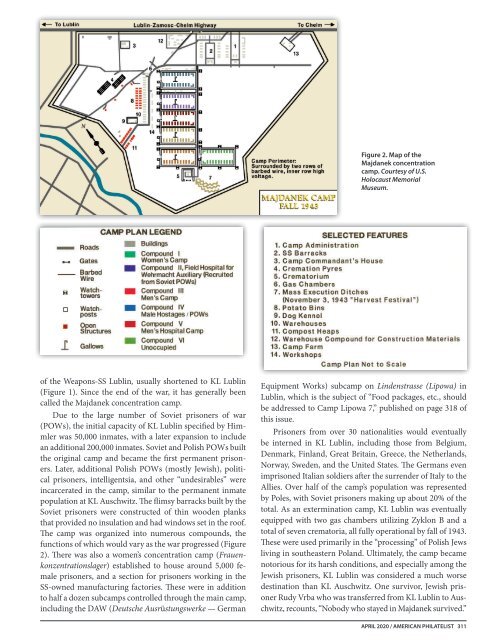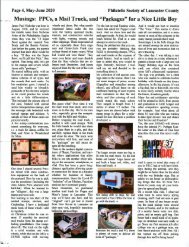The American Philatelist April 2020
Holocaust Rememberance Issue
Holocaust Rememberance Issue
You also want an ePaper? Increase the reach of your titles
YUMPU automatically turns print PDFs into web optimized ePapers that Google loves.
Figure 2. Map of the<br />
Majdanek concentration<br />
camp. Courtesy of U.S.<br />
Holocaust Memorial<br />
Museum.<br />
of the Weapons-SS Lublin, usually shortened to KL Lublin<br />
(Figure 1). Since the end of the war, it has generally been<br />
called the Majdanek concentration camp.<br />
Due to the large number of Soviet prisoners of war<br />
(POWs), the initial capacity of KL Lublin specified by Himmler<br />
was 50,000 inmates, with a later expansion to include<br />
an additional 200,000 inmates. Soviet and Polish POWs built<br />
the original camp and became the first permanent prisoners.<br />
Later, additional Polish POWs (mostly Jewish), political<br />
prisoners, intelligentsia, and other “undesirables” were<br />
incarcerated in the camp, similar to the permanent inmate<br />
population at KL Auschwitz. <strong>The</strong> flimsy barracks built by the<br />
Soviet prisoners were constructed of thin wooden planks<br />
that provided no insulation and had windows set in the roof.<br />
<strong>The</strong> camp was organized into numerous compounds, the<br />
functions of which would vary as the war progressed (Figure<br />
2). <strong>The</strong>re was also a women’s concentration camp (Frauenkonzentrationslager)<br />
established to house around 5,000 female<br />
prisoners, and a section for prisoners working in the<br />
SS-owned manufacturing factories. <strong>The</strong>se were in addition<br />
to half a dozen subcamps controlled through the main camp,<br />
including the DAW (Deutsche Ausrüstungswerke — German<br />
Equipment Works) subcamp on Lindenstrasse (Lipowa) in<br />
Lublin, which is the subject of “Food packages, etc., should<br />
be addressed to Camp Lipowa 7,” published on page 318 of<br />
this issue.<br />
Prisoners from over 30 nationalities would eventually<br />
be interned in KL Lublin, including those from Belgium,<br />
Denmark, Finland, Great Britain, Greece, the Netherlands,<br />
Norway, Sweden, and the United States. <strong>The</strong> Germans even<br />
imprisoned Italian soldiers after the surrender of Italy to the<br />
Allies. Over half of the camp’s population was represented<br />
by Poles, with Soviet prisoners making up about 20% of the<br />
total. As an extermination camp, KL Lublin was eventually<br />
equipped with two gas chambers utilizing Zyklon B and a<br />
total of seven crematoria, all fully operational by fall of 1943.<br />
<strong>The</strong>se were used primarily in the “processing” of Polish Jews<br />
living in southeastern Poland. Ultimately, the camp became<br />
notorious for its harsh conditions, and especially among the<br />
Jewish prisoners, KL Lublin was considered a much worse<br />
destination than KL Auschwitz. One survivor, Jewish prisoner<br />
Rudy Vrba who was transferred from KL Lublin to Auschwitz,<br />
recounts, “Nobody who stayed in Majdanek survived.”<br />
APRIL <strong>2020</strong> / AMERICAN PHILATELIST 311

















